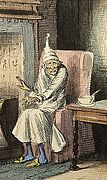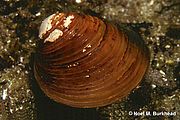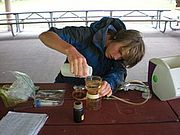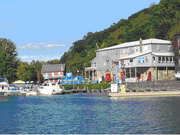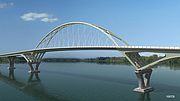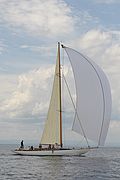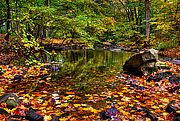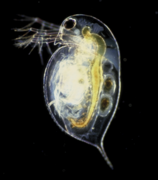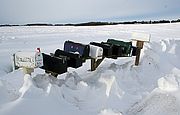Do you keep Lake Champlain in your heart through the year? LCC Staff Scientist Mike Winslow puts a Lake Champlain twist on Charles Dicken's 'A Christmas Carol'. Now you can hear him read his piece and see how the ghosts of the lake - Past, Present, and Future - helped change Ebenezer's outlook. Thanks to LCC member Greg Epler-Wood for his recording and sound editing efforts. Read...
News from Selected Month
The Rensselaer Polytechnic Institute Darrin Fresh Water Institute (DFWI) is leading a pilot project to assess the effectiveness of benthic barrier mats in controlling Asian clam (Corbicula fluminea), the newest aquatic invasive species in Lake George, NY. The pilot project is advised by the Asian Clam Rapid Response Task Force. Partners include technical experts from Lake Tahoe where spread prevention techniques for Asian clam are already underway. Read...
The Burlington Free Press reported that researchers from the University of Vermont (UVM) are conducting the first survey since the 1930s of lake whitefish populations in Lake Champlain, and the results have been promising. Whitefish are relatives of trout and salmon. Lake Champlain is near the southern edge of their habitat range. Up until the early 1900’s there was a strong commercial fishery for the species. However, declines in the quantity of fish taken led to closing the commercial market. When the UVM researchers surveyed historic spawning grounds in Missisquoi Bay and at Larrabees Point in Shoreham, they found no whitefish. Instead the fish seem to be spawning all throughout the Main Lake. Read...
Results from the Lake Champlain Committee's volunteer water monitoring program provide insight into the levels and locations of nutrient pollution. In 2010, significant algae blooms developed early during a July heat wave. Evidence of the bloom was reported from Burlington south to Port Henry, areas not usually associated with bloom conditions. These blooms cleared by mid-July. St. Albans Bay developed a bloom that persisted through much of July and into August. Blooms in Missisquoi Bay were less severe than in recent years and for the first time since 2007 no ‘high alerts’ (worrisome levels of actual toxins measured) were issued. Read...
The New York State Public Service Commission (PSC) conducted a series of public hearings about the proposal to place a cable underneath Lake Champlain to transport electricity to New York City. LCC testified about concerns regarding impacts to the lake and the overall need for the project. The PSC plans to hold evidentiary hearings in early 2011. LCC has applied for active party status in the case. The power line proposers must begin construction by fall of 2011 in order to qualify for federal loans. Read...
It was November of 2009 when the Champlain Bridge was suddenly closed for good due to structural weaknesses in the bridge supports. One year later the bridge is gone; destroyed in a controlled explosion last December. Debris from the original bridge has been removed from the lake, and construction has begun on a new bridge with an anticipated completion date of September 2011. According to the New York State DOT website, since early November, the construction activities at the site have focused on installing the bridge substructures, with work at all 7 piers and both abutments well underway. Fabrication of the steel bridge members is also progressing at a steel fabrication plant in Pennsylvania. The new bridge is being built by Flatiron Construction, a transportation construction and civil engineering firm based in Colorado. In the meantime, a ferry runs 24 hours per day transporting vehicles over the narrow stretch of Lake Champlain the bridge once traversed. Read...
LCC received a $1,500 gift from our friends at the Regatta for Lake Champlain. Established in 2004, the Regatta is a fun annual sailing event that raises funds to support organizations working to promote the health, well-being and sustainable use of Lake Champlain. Over the years, donations from the Regatta have helped fund LCC’s blue green algae monitoring program, maintain the Lake Champlain Paddlers’ Trail, and expand our stewardship efforts. Read...
Autmn’s panoply of colors blankets the mountains of the Champlain Valley. All summer the trees have been investing in short-term high-yield leaves to collect sunlight, and then placing the dividends in long-term wood. Now, they’re dumping their investment before the inevitable downturn, knowing that winter’s snow and winds would be more likely to pull down good wood if they tried to hold onto their leaves. Many of those leaves will end-up in headwater streams of Lake Champlain where they represent the primary energy input for the river system. Read...
On Lake Champlain we have become accustomed to winters when the lake no longer freezes over completely. From the mid 1800s, the time of the first available records, until the 1950s it was almost a given that the lake would freeze over each year. Since then, on average the lake freezes every other year. However, on many lakes freeze over is still a regular occurrence, and a recent report from Germany suggests that when lakes that regularly freeze do not, the results can be dramatic. Read...
If you’ve had an address change recently, please send us an email so we can correct your files and ensure that we keep you updated on lake issues and LCC’s work. LCC’s primary form of communication with members is through email. By mailing electronically we save time and resources and reinforce the stewardship ethic of our mission. We don’t give away or sell email addresses. To ensure that our email messages get through to your inbox, please add lcc@lakechamplaincommittee.org and the domain enews.lakechamplaincommittee.org to your safe/allowed list and address book. Read...

